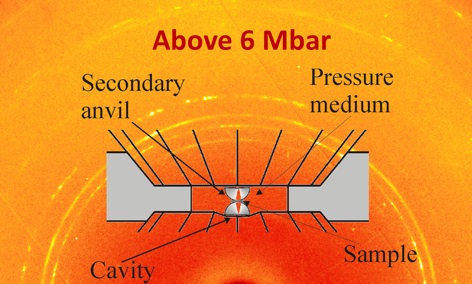Using a novel form of diamond that is even harder and more durable than the conventional gemstones, a team from the universities of Antwerp, Chicago and Bayreuth (in Germany) has developed apparatus that can subject solid materials to pressures of 640GPa — higher than those found at the centre of the Earth.

High pressures can cause materials to behave strangely: metals can become insulators, non-metals can become superconducting and chemical properties can change. Materials scientists are keen to study these transformations, while Earth scientists and cosmologists use these techniques to investigate the behaviour of materials at the centre of planets. Engineers can also use high pressure to determine how materials behave under extreme shockwaves.
These high pressures are generally achieved using diamond anvil cells, where very small samples are squashed between the surfaces of gem-quality diamonds. But diamonds are limited for this purpose because their crystalline structure means they have inherent planes along which they can break. The upper limit of anvil cells is 320–360GPa, which is around the pressure of the Earth’s core.
To reach higher pressures, researchers have used the pressure of shockwaves, but these have two drawbacks: they generate high temperatures and the pressure only lasts for a very short fraction of time. ‘The ability to do static experiments at this pressure range has only been dreamed about,’ said Vitali Prakapenka of Chicago University’s centre for advanced radiation sources.
The team devised a new type of diamond anvil that incorporates ‘sub-anvils’ between the two single-crystal diamonds, which press on the sample. These sub-anvils are hemispheres of nanocrystalline diamond around 10–20 microns in diameter, made from a glassy form of carbon made under high temperature and pressure.
Discovered last year, this glassy carbon is as hard as diamond but does not contain crystalline planes. ‘The nanocrystalline diamond balls have very high yield strength and are less compressible and less brittle than single-crystal diamonds,’ said Natalia Dubrovinskaia of Bayreueth University.
The cell can only work with very small samples, less than a micron thick, but can reliably and repeatedly reach the kinds of pressures that have not been achievable with static experiments. The team has been conducting experiments using X-ray crystallography to probe the samples at the Argonne National Laboratory in Illinois and explains its results in the current issue of Nature Communications.
‘We aren’t stopping there,’ said Prakapenka. ‘We expect to increase the accessible pressure range to one terapascal, or 10 megabars, to probe materials at conditions corresponding to the core of giant gas planets, such as Jupiter or Neptune, which have pressures of about seven megabars.’




Red Bull makes hydrogen fuel cell play with AVL
Formula 1 is an anachronistic anomaly where its only cutting edge is in engine development. The rules prohibit any real innovation and there would be...